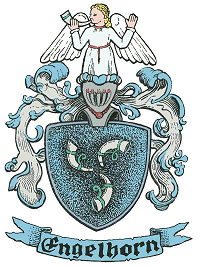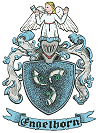From the Denver Evening Post 30 March 1900 after the celebration of the golden wedding of Thomas Gottlieb and Jane (Vaughn) Engelhorn.
LIVED TOGETHER FIFTY YEARS
The stalwart, good-looking swain, his brow furrowed a trifle by well meaning wrinkles, his hair showing streaks of gray, caught his sweetheart's hand. The face of the sweetheart likewise was furrowed, for seventy years had passed over it; her soft hair also was touched with gray - but with beaming face, her hand tucked under the arm of her partner, she waited the first strains of the fiddle, the signal for the grand march of their golden wedding dance.
In the whirl that followed the leaders of the grand march held their own among their children and grandchildren and great-grandchildren and stepped and wheeled over the waxed floor as gracefully and as charmingly as the lithest.
Euclid Hall never entertained so unique a party as that golden wedding of Mr. and Mrs. T.G. Engelhorn of 3640 Justine Street last Saturday evening. It was a memorial of one of the happiest matings that ever took place in Marietta, Penn. though that event happened just fifty years ago.
“And we thought it the most important event, too, that had ever happened there” said the groom, “when Jane in her accordion pleated purple silk and I in my long frock coat stood up before the minister on March 24.”
“She didn't know how I had maneuvered around to bring it all about, either, until a good while afterwards. The first time I saw my wife - Jane Vaughn she was then - she was standing in front of her father's big house and looking off down the street. There's no use talking, she was a real beauty, Jane was, the prettiest girl in the whole town, everybody said. Well when I saw her standing there I was just taken in completely I called one of the boys and asked who she was. When he told me I said: ‘Well, I'm going to set my cap for her,’ and I was just a carpenter in the town, mind you.
“He looked at me and said I needn't take the trouble, that it wouldn't be any use, for Jane wouldn't look at me, and besides, he said there was one already that she liked and who was sure to get her. I didn't say anything, but I went to work at the proposition, and before anybody knew it I was taking her to church, and after a bit we were engaged.”
The story of this conquest exhumed from the annals of the past seventy-two years gives great zest to the reflections of the successful Lochinvar of today, and the great-grandchildren listen and think it a very interesting train of thought that their ancestor has fallen into.
Five years after their marriage the Engelhorns went to Iowa. There they lived until May, 1874, when they moved to Nebraska, to remain thirteen years. Since 1897 they have made their home in Denver. Mr. Engelhorn has been a carpenter all his life, and many handsome buildings in the towns where he has lived show the work of his hands.
The piece of work upon which he spent the longest time, and in which therefore he takes great pride, is the great brick hotel in Altoona, Ia., built shortly after his marriage. On this he worked for two years.
Of the 55 descendants of this couple, 12 were present and danced at the golden wedding.
The family proper consists of eight children. They are William and George Engelhorn, both unmarried and living at home; Mrs. Thomas Thompson, of Lansing, Ia.; Mrs. John Thomson of Churchs Ferry, North Dak.; Mrs Frank Golly of Zearing, Ia.; Mrs. Adolph Ulrich, The Dalles, Ore.; Mrs. William Beam, of California; and Mrs. John Gahley, of Nebraska. Mrs. Gahley came to Denver to attend the wedding, and will visit for a short time with her parents.
The families, further multiplied, consist of 39 grandchildren and eight great-grandchildren. The heads of this great family are still comparatively young and well preserved. And it is extremely likely that they may live to see other generations grow up around them.
Many beautiful gifts were received by them in honor of the occasion of Saturday; among them the most valued was a $20 gold piece from the Eagle Athletic Club.
(This article appears as Appendix B in the Blue Book.)

